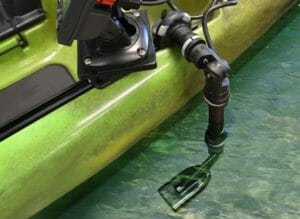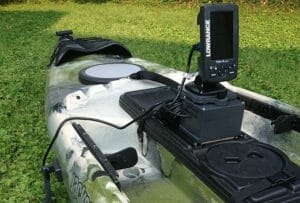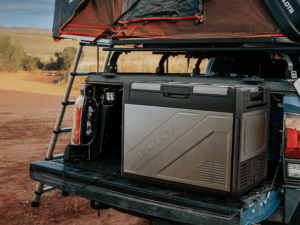
So you’ve bought a shiny, new fish finder for your kayak. That may be all well and good, but do you know how to attach it to your kayak? Doing so used to be a bit of an ordeal, as you would need to make permanent physical modifications to your kayak that could make it unfit for use if done improperly. Your safest bet would be to take it to a professional to install, but that could cost a bit extra. Nowadays, though, it’s become a little easier to mount one of these useful tools to kayaks, especially since so many fishing kayaks actually have spaces built-in for specific brands of fish finder.
Here, this fish finder guide will be showing you the basics of how to attach the best fish finder and its transducer to your fishing kayak, whether it be one with a fish finder mount built-in or not. While attaching one to a kayak without a mount is going to be more difficult than one with, that doesn’t change the fact that not everyone has these specialized kayaks available. It’ll help to know how to deal with both types of kayaks for future reference.
Part 1: The Transducer
 The transducer is the main sensory unit of many fish finders, so as such it is vital that you install yours properly. Failure to do so will result in your fish finder providing inaccurate readings, which would pretty much make the thing useless. Those using kayaks made specifically for fishing may find that the scupper holes near the front of the kayak are made in such a way as to accommodate transducers. This is perhaps the most optimal solution, as this allows the transducer to have direct contact with the water, thereby allowing for more accurate readings.
The transducer is the main sensory unit of many fish finders, so as such it is vital that you install yours properly. Failure to do so will result in your fish finder providing inaccurate readings, which would pretty much make the thing useless. Those using kayaks made specifically for fishing may find that the scupper holes near the front of the kayak are made in such a way as to accommodate transducers. This is perhaps the most optimal solution, as this allows the transducer to have direct contact with the water, thereby allowing for more accurate readings.- Traditional kayaks do not have this luxury, however, and so must make do with another solution. Typically, this involves sticking the transducer inside of the kayak, at the very front and on the floor. For this, a strong, bonding adhesive or epoxy (“Marine Goop” is often cited as the best material) needs to be spread underneath the bottom of the transducer, then placed on a sanded-down and smoothed-out section of the kayak floor. In the case of Marine Goop, it takes about a full day, pressed down with a weight of some sort, for a transducer to be fused onto your kayak.
- With either case, you need to make sure your transducer is secured onto your kayak, mounted firm enough to where the movements of your boat moving through the water will not interfere with its readings. One of the primary advantages of using an adhesive like Marine Goop is how flexible of an adhesive it is, despite how well it sticks. Its composition makes it to where the shocks from sudden movement won’t easily disturb the transducer. Most built-in transducer mounts, including scupper mounts, are built with this sort of flexibility in mind.
Part 2: The Unit Itself
 Once you have the transducer mounted and ready to go, the next step is to install the part most people refer to as the fish finder itself: the display unit. This, of course, is where you’ll be reading the information being taken in from the transducer, and as such it is important to have it mounted where you can read it easily in your kayak, and where it won’t be at risk of damage, from water or otherwise.
Once you have the transducer mounted and ready to go, the next step is to install the part most people refer to as the fish finder itself: the display unit. This, of course, is where you’ll be reading the information being taken in from the transducer, and as such it is important to have it mounted where you can read it easily in your kayak, and where it won’t be at risk of damage, from water or otherwise.- The ease at which one can mount a display unit in a fishing kayak is, perhaps, one of the greatest advantages to having a modern kayak built for fishing. Most quality fishing kayaks have a place to install fish finder sockets to mount your device on. The best of these will have these in areas where you can easily and quickly look at your display unit to see what fish and hazards lie before and below your ship. Typically, mounting a display unit is as simple as placing it in the designated hole, bolting it in if necessary.
- For kayaks without this feature, on the other hand, things are going to be a little more difficult, as this is where making modifications to your kayak will be necessary. One advantage to mounting your display unit yourself is that you get to choose where it goes on the boat. Just be sure to take into consideration where the other components of your kayak are; you would not want to damage your display unit just because you placed it too close to your rod or paddle holders!
- When you’ve found a good place to mount the display unit, you’ll need to drill a hole to run the necessary cables from the transducer to the display unit. This will require a hole only a few centimeters wide, just large enough to run the cables through. Some fish finders may come with rubber material to place in this hole and keep the wires in place, though it has been said that making one out of a rubber cork, a small blade, and a drill bit the width of your wires isn’t too hard, either. Just be sure that your wires are secured within the hole.
- Once you’ve done this, you may need to drill a few more holes to install a mount for your display unit, but these will often come with their own instructions, as their methods of installation are pretty diverse.
Conclusion
The methods listed here are not the only ways to install a fish finder onto your kayak. In fact, the methods by which people have installed fish finders vary wildly, with some going as far as to install arms designated to hold their fish finder onto the kayak. These drastic modifications aren’t typically needed to get fish finders to work with your boating setup, and are best left with master modders who know what they’re doing. Rather, this is all just a summary of what I’ve learned from researching the subject and working with kayaks firsthand.
The general gist of things is to make sure to keep your components secured, dry, and easy to access. Fishing kayaks will often have places to install your fish finder, but making basic modifications to other kayaks is a relatively painless process if time is taken to do it right. Hopefully, this information will help you with mastering this process, so that your kayak fishing trips go well!







